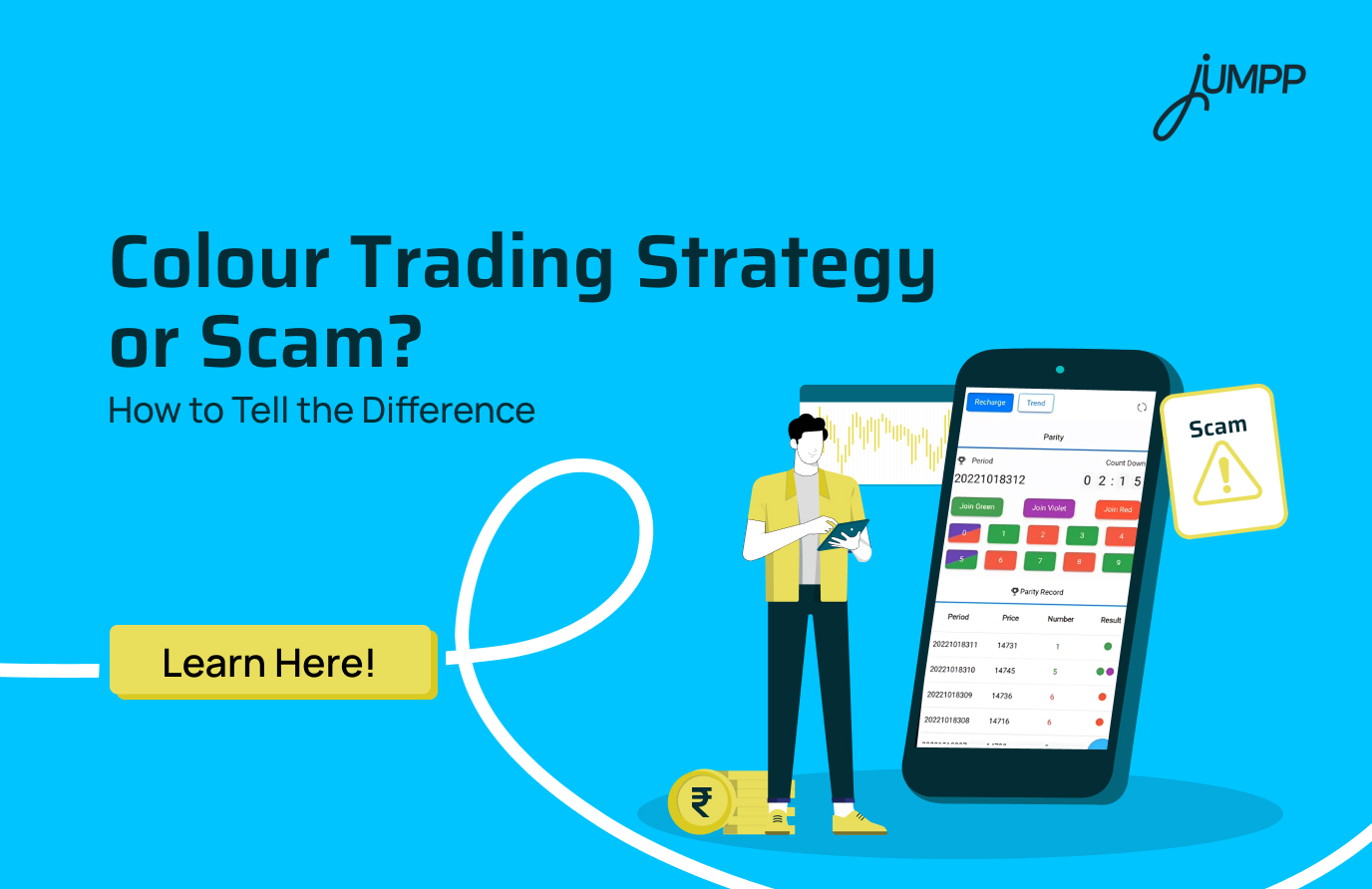What is Colour Trading- Meaning, Benefits and Risks

Most of us think that stock market trading involves mutual funds, bonds, stocks, ETFs or commodities. But there’s another niche form of speculation that you may have never really heard of. It is called colour trading. Yes, colours like red, green, and yellow are used as important indicators on a digital trading platform. This is a setup where people bet on the outcome of colour changes. It’s simple to join, but the way it works and the colour trading rules around it might surprise you. Let’s exactly see what is color trading and if it is legal everywhere?
What is Colour Trading
Colour trading refers to a visually driven online prediction or speculative trading activity. In this digital betting-style activity, people try to guess which colour will appear next on the screen or chart. The colours are usually red, green, or sometimes violet, and the outcome is used to decide whether participants win or lose money.
Now, if we talk about the real meaning of colour trading for most of the existing traders and investors, it simply refers to using colour-coded indicators on trading charts to make decisions.
For example, green may indicate an upward or buying trend, red may suggest a downward or selling trend, and other colours like orange may signal a neutral or caution phase.
Most of the traders use these visual signals along with other technical analysis tools such as moving averages, candlestick patterns, and volume data to make faster decisions. Long-term investors might also refer to these signals when choosing a good entry or exit point for their holdings.
Features of Colour Trading
You just pick a colour, and within seconds you know if you’ve made money or lost it.
Let us explore the unique features of colour trading.
1. Simple Setup
Colour trading platforms usually have a very basic interface. The main screen shows different colour options, most commonly red, green, and sometimes other shades like violet or blue. There are no complex stock charts or market depth windows to study.
2. Fixed Time Rounds
Each round in colour trading has a set duration, such as 30 seconds, 1 minute, or 3 minutes. Players have to choose a colour before the timer runs out. Once the time ends, the winning colour is revealed instantly.
3. Pre-Defined Odds
The payout for guessing the correct colour is usually fixed. For example, if you put ₹100 on a colour and the odds are 2x, you win ₹200 if your guess is correct. These odds don’t depend on market movements, unlike stock trading.
4. No Link to Real Market
Unlike equity or commodity trading, the outcome of colour trading has no connection to the Sensex, Nifty, Nifty 50 or any other asset. The result is generated by the platform itself, often using algorithms or random number generators.
Invest safely in the stock market with open a free demat account!
5. High-Speed Results
Results are revealed quickly after each round. This is one reason why people find it addictive, as they get instant wins or losses without waiting for market hours to end.
6. Minimal Entry Barrier
Most platforms allow very small amounts to start, sometimes as low as ₹10 or ₹20 per bet. This makes it accessible to anyone.
7. High Risk
Since outcomes are not based on skill, market analysis, or company fundamentals, the risk of losing money is extremely high. It is closer to gambling than trading and is not legally recognised as a trading activity in India.
How Colour Trading Works
Most colour trading platforms run in very short rounds, often lasting just 30 to 60 seconds. At the end of each round, a colour is shown, usually decided by an algorithm or a system designed to appear random.
- Users place bets on which colour will come up next.
- If they guess correctly, they win an amount (often 1.8–2x the amount they initially put on the bet).
- Game rounds repeat frequently, encouraging rapid participation and escalating wagers.
Alternatively, if we talk about the well-regulated financial trading, “colour trading” denotes using colour-coded charts.
Like green for bullish trends, red for bearish, yellow/orange for caution, as a tool for quick decision-making. Here, the focus lies on visual signals derived from market data, not chance or random outcomes.
Colour trading works in two completely different ways, depending on whether we are talking about the legal chart-based method or the illegal betting-style method.
1. Legal (Chart-Based) Colour Trading – How It Works
This method is part of real market analysis and uses colour-coded signals on trading charts to help traders quickly interpret price movements.
1. Trading platforms assign colours to trends – for example:
- Green tends to depict a bullish signal (prices may rise)
- Red shows a bearish signal (prices may fall)
- Light red/ Orange means neutral or caution zone
2. Indicators change colours when market conditions shift.
3. Herein, you usually act on the signals by buying, selling, or holding positions.
For example, if you have been watching Tata Motors shares, you will probably buy them when the chart changes from red to green and sell when it turns red again.
4. The decision-making is skill-based. The trader uses the colours as part of a wider decision-making strategy that includes volume, patterns, and fundamentals.
2. Illegal (Betting-Style) Colour Trading – How It Works
This is not real trading and is closer to online gambling.
1. The platform displays a timer for a round, usually 30–60 seconds.
2. The user chooses a colour and places a monetary bet.
3. When the timer ends, the platform randomly shows a “winning” colour.
4. If the chosen colour matches the result, the user “wins” a payout; if not, they lose the amount.
5. The results are controlled by the platform’s algorithm. They can also be manipulated.
6. This form of colour trading is illegal in India, unregulated, and often part of scams where withdrawals are blocked.
The Truth About “Colour Trading Strategy” Promoters Push
Promoters of colour trading platforms often claim they have special tricks or guaranteed formulas to win money quickly.
In reality, these so-called “colour trading strategies” are nothing more than bait to make you deposit more money.
1. Fake Pattern Predictions
Promoters tell you to study previous rounds to “spot patterns” in colour results. In reality, results are generated by the platform’s algorithm and can be changed anytime.
2. The “Secret Tip” Trap
Many promoters run Telegram or WhatsApp groups, claiming they know which colour will appear next. They pretend to have insider information, but their goal is only to gain your trust and convince you to invest more.
3. Early Winning Streaks
Some platforms allow new users to win in the first few attempts. This creates the illusion that their tips or tricks work. Once you start betting bigger amounts, the wins stop, and withdrawals often get blocked.
4. Referral Chain Scams
You may be told you can earn commissions by inviting friends or family. This turns victims into unintentional promoters, spreading the scam further.
5. Fake Wins and Testimonials
Platforms often post fake screenshots and success stories to make you believe people are making easy money.
Colour Trading Rules They Don’t Want You to Know
How do you spot a colour trading platform before it’s too late?
You need to keep an eye on these red flags:
- Don’t fall for “double your money in minutes” type messages.
- The platform promises guaranteed or unusually high returns in very short periods.
- Company ownership details are hidden or vague.
- A quick online search shows scam reports, cybercrime warnings, or news of police action.
- It’s not registered with SEBI, RBI, or any government financial regulator.
- There’s no real investment involved. That means you are not buying shares, commodities, or currencies.
- Users often complain about payouts being blocked or accounts being suspended.
- Heavy promotion via referral schemes, WhatsApp groups, or social media influencers.
- Fake reviews and testimonials flood their marketing material.
Why You Should Never Get Involved in Colour Trading
Even if you’re tempted to try, here’s why colour trading should be avoided completely:
- There’s no stock, commodity, or currency involved
- Unregulated platforms can refuse withdrawals or disappear without warning.
- If you lose money, you can’t file an official complaint or recover your funds.
- The fast-paced rounds make it mentally addictive and financially destructive.
- Many platforms have been exposed in police cases and cybercrime alerts.
- They flourish on false guarantees, staged screenshots, and influencer promotion.
Is Colour Trading Legal in India
Wondering if colour trading legal in India? The answer is no.
Colour trading is not legal in India.
In India, activities like colour trading are considered a form of online gambling, not real trading. Since gambling (except in a few regulated forms like lotteries in some states or horse racing) is prohibited under most Indian laws, such platforms operate outside the legal framework.
The Reserve Bank of India (RBI), Securities and Exchange Board of India (SEBI), and state governments do not recognise colour trading as a legitimate investment or trading activity. This means:
- There is no investor protection.
- If you lose money, there is no legal recourse.
- Many of these platforms operate illegally and can shut down without warning.
Legal Dangers of Playing Colour Trading in India
If you participate in colour trading, you’re not just risking your money—you could also face legal trouble:
- Classified as a game of chance under the Public Gambling Act, 1867, and various state laws, which can lead to fines or criminal charges.
- You can’t approach SEBI, RBI, or the consumer courts for help if your money is lost.
- Many platforms have been linked to scams with no refund possibilities.
- Authorities can freeze your accounts or seize assets during investigations.
- Police and cybercrime units have arrested both operators and users of colour trading apps.
How Does Colour Trading Differ from Traditional Stock Trading Strategies?
Colour trading involves betting on which colour will appear next in a fast-paced, short-round format. This is different from traditional stock trading.
In the case of real stock market trading, you deal with buying and selling actual stocks or assets based on fundamental and technical analysis over varying time frames.
Traditional trading relies on market data, company performance, and economic indicators.
However, colour trading in the gambling sense is mostly luck-based, with outcomes driven by algorithms or random generators.
In regulated financial markets, ‘colour trading’ refers to using colour-coded charts to visually interpret market trends (e.g., green for buy, red for sell). Still, it is just one aspect of a broader strategy that also includes various indicators and risk management. Traditional trading is legal and regulated, while gambling-style colour trading is illegal in India.
Want to understand how risks relate to potential rewards?
Check out our detailed guide on the difference between risk and return to make smarter trading decisions.
Conclusion
Colour trading, when limited to visual chart indicators in finance, is a legal and useful analytical strategy. However, betting on random colours via apps or websites is illegal gambling in India and exposes users to scams, asset seizures, and prosecution.
You must always verify any trading platform’s regulatory license. If you encounter a “colour trading” scheme promising guaranteed profits or instant returns, exercise extreme caution: it is likely a fraud and is illegal under Indian law.
What is Colour Trading- FAQs
Colour trading is an online activity where users bet on which colour (like red or green) will appear next. It is a form of digital gambling, not actual stock market trading.
No, colour trading is illegal in India as it is considered online gambling and is not regulated by SEBI or any financial authority.
Players choose a colour and place money on it; if that colour appears after a short timer ends, they win, otherwise they lose their money.
Colour trading is not a legitimate financial market activity. Most platforms offering it are scams or illegal gambling sites.
While some people may win temporarily, most lose money because it is purely luck-based and often manipulated. You should be very cautious while getting involved in it.
There is no “best” app, as colour trading apps are illegal and unsafe in India. Using them can lead to financial and legal trouble. You could rather invest your hard arned money in the regulated stock market.






